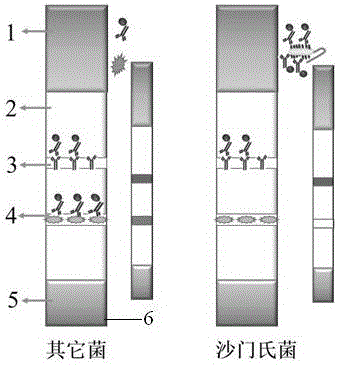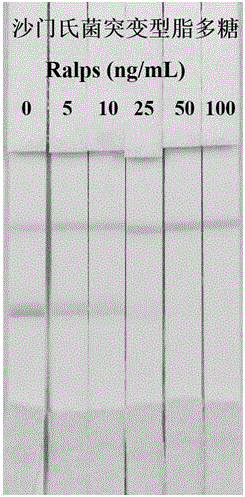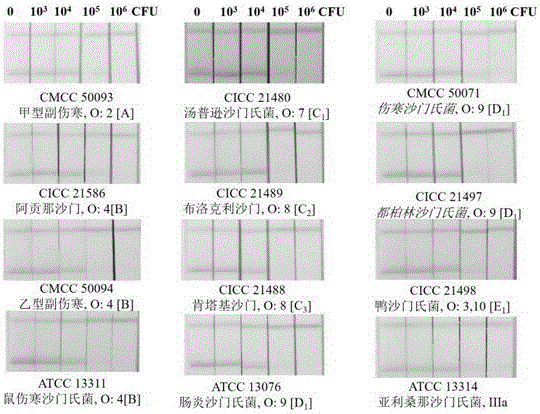Preparation method of colloidal gold test paper strip for detecting salmonella in food based on salmonella core polysaccharide monoclonal antibody
A monoclonal antibody, colloidal gold test paper technology, applied in the field of immunoassays, can solve the problems of difficult exposure of core polysaccharides, difficult to effectively capture antibodies, and insufficient satisfaction, and achieve the effects of high affinity, low cost, and cross uniformity.
- Summary
- Abstract
- Description
- Claims
- Application Information
AI Technical Summary
Problems solved by technology
Method used
Image
Examples
Embodiment 1
[0030] The concrete steps of this colloidal gold test strip development are:
[0031](1) Preparation of Salmonella core polysaccharide monoclonal antibody SQX6D8:
[0032] Using the immunogen synthesis method disclosed in Patent Application No.: 201410314040.3, 1-(3-dimethylaminopropyl)-3-ethylcarbodiimide hydrochloride (EDC) and N-hydroxysuccinimide ( NHS) method to synthesize mutant Salmonella lipopolysaccharide (Ra-LPS) and keyhole limpet hemocyanin (KLH) complete antigens, and as immunogens to immunize mice, through routine cell fusion and Salmonella cells with LPS and different O antigens as package The positive cells were screened by the original, and finally the genus-specific monoclonal antibody SQX6D8 with high affinity and uniform crossover to Salmonella was prepared.
[0033] (2) Synthesis of T-line-coated original LPS-BSA conjugate: Synthesize the conjugate using the synthesis method disclosed in Patent Application No.: 2014103140403, and the specific steps are as...
Embodiment 2
[0039] Embodiment 2 adopts this colloidal gold test strip to detect Salmonella Ra LPS:
[0040] First, Ra LPS (1mg / mL) was diluted with 0.01M phosphate buffer to 100 ng / mL, 50 ng / mL, 25 ng / mL, 10 ng / mL and 5 ng / mL, blank 0.01M phosphoric acid Salt buffer as a control;
[0041] Then use the wet method to detect Ra LPS, take 7 μL of the gold-labeled antibody prepared in step (4) of Example 1 and 47 μL of the resuspension (0.1% Tween, 0.2% sucrose, 1% BSA in 0.01M phosphate buffer ) into the microplate and mix with a pipette. Add 150 μL of different concentrations of Ra LPS to different microwell plates, mix well with a pipette gun, and react at room temperature for 5 minutes; insert the prepared colloidal gold test strip into the microwell plate, and react at room temperature for 10 minutes to read. Interpretation basis: blank sample, quality control line and test line have color at the same time, and the test line has a darker color, positive sample. The quality control lin...
Embodiment 3
[0042] Embodiment 3 Adopt this colloidal gold test strip to detect 12 strains of Salmonella:
[0043] The 12 strains were Paratyphoid A (Group A) CMCC 50093, Salmonella Agona (Group B) CICC 21586, Paratyphoid B (Group B) CMCC 50094, Salmonella Typhimurium (Group B) ATCC 13311, Tompu Salmonella genus (group C1) CICC21480, Salmonella Brockley (group C2) CICC 21489, Salmonella Kentucky (group C3) CICC 21488, Salmonella enteritidis (group D) ATCC13076, Salmonella typhi (group D) CMCC 50071, Salmonella Dublin (group D) ) CICC 21497, Duck Salmonella (Group E) CICC 21498, Arizona Salmonella ATCC 13314.
[0044] The specific detection process is as follows: the pure culture of Salmonella tested is diluted to 10% with 0.01M phosphate buffer solution. 7 CFU / mL, 10 6 CFU / Ml, 10 5 CFU / mL and 10 4 CFU / mL, the diluent was used as a blank control, and other processes were the same as in Example 2. Specific test results such as image 3 shown.
PUM
 Login to View More
Login to View More Abstract
Description
Claims
Application Information
 Login to View More
Login to View More - R&D
- Intellectual Property
- Life Sciences
- Materials
- Tech Scout
- Unparalleled Data Quality
- Higher Quality Content
- 60% Fewer Hallucinations
Browse by: Latest US Patents, China's latest patents, Technical Efficacy Thesaurus, Application Domain, Technology Topic, Popular Technical Reports.
© 2025 PatSnap. All rights reserved.Legal|Privacy policy|Modern Slavery Act Transparency Statement|Sitemap|About US| Contact US: help@patsnap.com



